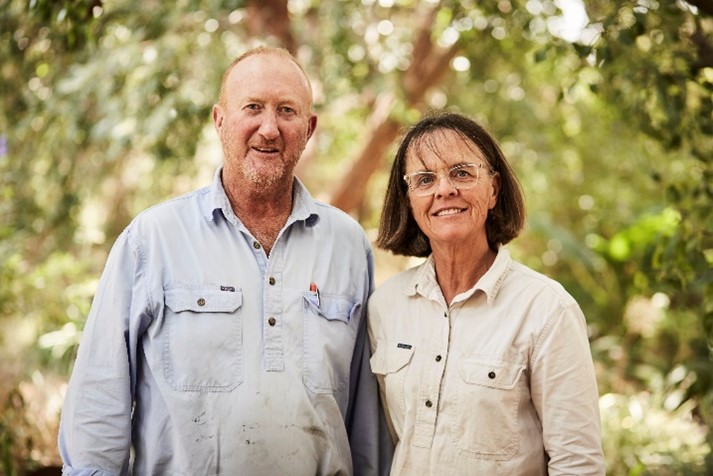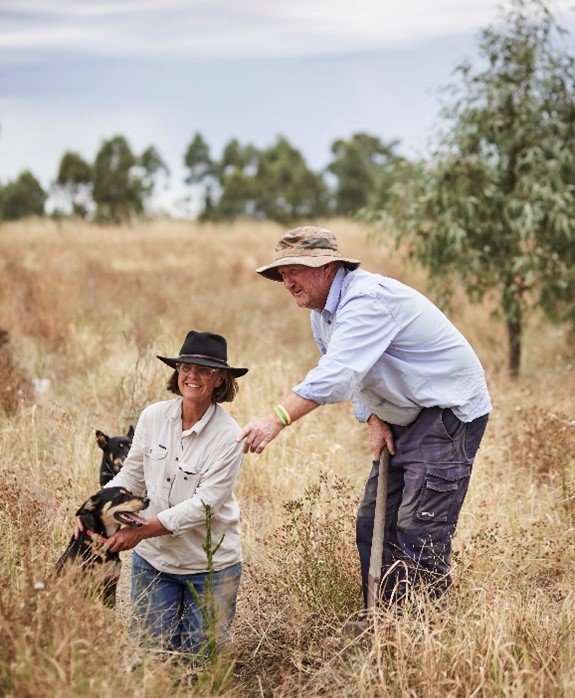Cutting through the noise around carbon farming

About the farm
- Jo and Greg Bear run a 6,645 ha sheep property at Loddon Vale, North Central Victoria, Baraba Baraba country.
- There are 7,000 head of sheep, made up of self-replacing Merino and first cross lambs, lambing in autumn to early winter.
- Over the farm there is remnant vegetation and improved pasture species, including some irrigated lucerne and annual ryegrass pastures.
- Average annual rainfall is 358 mm.
- The soil types are Kerang and Tragowel clays.
- Several creeks and rivers cross the property, with 80% of water frontage and dedicated wetland areas fenced off. There are 71 hectares of shelterbelt plantations that are around 12 years old.
Farming and carbon emissions
In Australia, there’s a big focus on how farms manage greenhouse gas (GHG) emissions and store carbon. Efficient production to manage and reduce emissions is becoming increasingly important.
Agriculture Victoria’s On-Farm Emissions Action Plan Pilot is working with Victorian farmers to know, understand, and act on their farm GHG emissions.
Jo Bear wants to be as informed as possible when making decisions on production efficiency and on-farm emissions impact of their sheep enterprise in North Central Victoria.
As a farming community there's so much noise about carbon farming or emissions, a lot of that noise is negative and it's really hard to get really accurate information.
Jo signed up to Agriculture Victoria’s On-Farm Emissions Action Plan Pilot in the hope it would reduce confusion she felt from the noise related to carbon farming and emissions.
‘I wanted to get some carbon literacy. I just wanted to know what things mean. I thought, gosh what better way than having your own farm business measured and having someone come to your farm and talk to you one-on-one about what impacts our farming practices have’, said Jo.

As part of her involvement in the Pilot project, Jo was given an emissions assessment of the enterprise, had a one-on-one visit from a technical expert who explained the assessment and what solutions are feasible. A Farm Emissions Action Plan was delivered with associated Grant funding to implement on emissions reduction and/or carbon sequestration action on farm.
Jo considers that an integral part of being involved in the Pilot program has been the benchmarking of their on-farm emissions and being part of peer-to-peer learning with the broader community.
‘We get to meet our other peers, other farming businesses that are involved in this program and that's really great. We all know as farmers how much we learn by talking to other farmers. We want to know how we stack up. We think we've got an environmental bent but really does that stack up at the end of the game?’, said Jo.
Historically the farm has placed a strong focus on production efficiency through monitoring and selection of the ewes, maximising lamb survival by setting smaller flock sizes before lambing and using vasectomised teaser rams to support reproductive success.
Over the summer stock containment areas are used to rest paddocks with most supplemental feed purchased locally. The livestock are also turned off as quickly as possible to reduce feeding costs and increase efficiency of the business.
Know Your Number
‘Know Your Number’ is a way to measure the greenhouse gas (GHG) emissions from a farm using a special tool like the Greenhouse Accounting Framework (GAF) calculator.
This number is the total amount of carbon dioxide equivalents (CO2-e) produced by the farm each year. It includes three types of emissions, called scopes:
- Scope 1: Emissions from livestock (like enteric methane from sheep and cows), nitrous oxide from nitrogen fertilizer application, urine and dung and carbon dioxide from fossil fuel use.
- Scope 2: Emissions resulting from the electricity the farm uses.
- Scope 3: Emissions created in manufacturing products the farm buys (embedded).
Farms can also capture and store carbon in trees and soils, a process known as carbon sequestration. This captured carbon can be used to balance against their emissions, which is called ‘insetting’.
Research from the Blue Carbon Laboratory at Deakin University highlighted that unfenced dams are likely to emit methane in the order of 5.7 t CO2-e/ha per year1. Breaking the data down to a 30 × 30 m unfenced dam, emissions could approximately be 0.5t CO2-e per year. Compared to other sources of emissions on-farm this is small but regardless of this scope, there is still opportunity to reduce emissions and increase co-benefits.
Acting to reduce emissions
A Pilot Action Plan grant is supporting further tree planting (8 ha) and fencing to isolate stock from water ways to further reduce net emissions. Longer term, the focus is also on flock production efficiency through feed optimisation and live weight monitoring for reducing turn-off time and decreasing emission intensity of lamb and wool production.

When considering emissions reduction actions the Bears could take on their property, they identified co-benefits they wanted to also aim for to ensure their actions had the greatest benefit.
‘We wanted our actions to have multiple benefits, of which we are really keen to improve animal health, increase shade and shelter, reduce erosion and increase biodiversity especially given the amount of river and creek frontage and water bodies on the farm,’ said Jo.
Improving their water reticulation system so it reaches more of the farm also means the Bears are more climate resilient when faced with the next dry season.
‘By improving and extending the reticulation system with additional troughs and tanks we can reduce the amount of nitrogen from manure run off, reduce erosion risk and increasing biodiversity as we fence off and plant around the river, creeks and dams.’ said Jo.
Animals with access to trough water systems drink more water and eat more which ultimately leads to quicker weight gain. This is important to the Bears as animal health and efficient turn off times results in better emissions intensity outcomes.
‘To run a profitable business, we need to make sure our animals are as healthy as possible, reducing the risk of mortality and increasing lamb survival. Improving our stock water is a huge win/win for our financial viability and for reducing emissions,’ said Jo.
The future
The additional fencing and tree planting is a 5 to 10-year plan for the Bears.
Jo said, ‘We have a plan to focus on the north-west to westerly aspects of the property to maximise shade and shelter from hot winds we experience in summer. We are also making sure we link in with plantings of neighbours to maximise the benefit of wildlife corridors. We also believe that both plant species and stock inherently thrive in an area surrounded by trees, bushes and natural waterways. The ecosystem is balanced’.
The reality is we're going towards the whole world being carbon neutral by 2050 so we can't be left behind
Jo believes they are now in a better position to ensure their business is viable into the future.
This case study is part of a series outlining practical actions Victorian farmers are implementing on farm as part of the Agriculture Victoria, On-Farm Emissions Action Plan Pilot program .
Acknowledgements
Authors – James Nuttall, Jemma Pearl, Agriculture Victoria, 2024
For further information on the project email actionplanpilot@agriculture.vic.gov.au
The On-Farm Emissions Action Plan Pilot is part of the Victorian Government’s Agriculture Sector Emissions Reduction Pledge to provide practical information, tools and services to support farmers to understand and reduce emissions.
The Pilot will work with up to 250 farm businesses across the state to estimate their on-farm emissions profile and identify potential actions to manage and reduce emissions while maintaining productivity and profitability.
References
1. Malerba ME, Lindenmayer DB, Scheele BC, Waryszak P, Yilmaz IN, Schuster L & Macreadie PI (2022). Fencing farm dams to exclude livestock halves methane emissions and improves water quality. Global Change Biology, 28, 4701–4712. https://doi.org/10.1111/gcb.16237
Selling carbon from trees and soils
Learn more about soils and carbon at Soils and carbon for reduced emissions
Jo Bear joined Agriculture Victoria’s Emissions Specialist Alison Kelly at the North Central Catchment Management Authority’s Natural Capital Forum in June 2024. You can watch their presentation here: https://www.youtube.com/watch?v=TBhI9vufC_g&t=1s